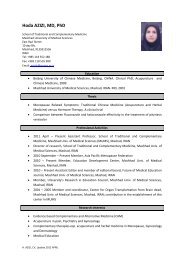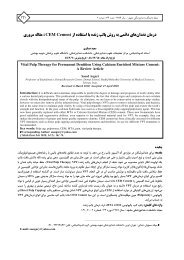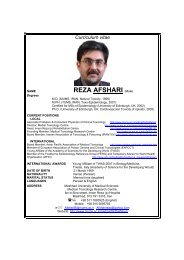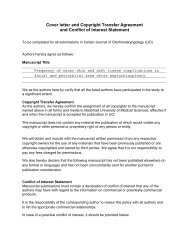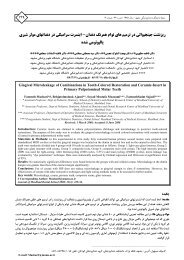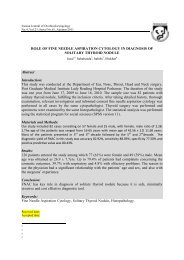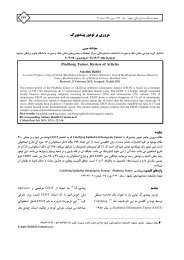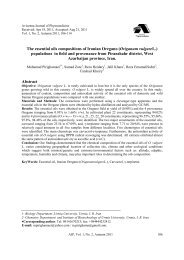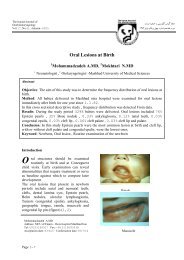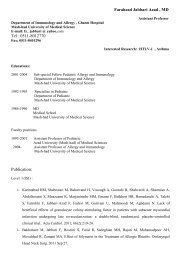Predisposing Factors for the Complications of Deep Neck Infection
Predisposing Factors for the Complications of Deep Neck Infection
Predisposing Factors for the Complications of Deep Neck Infection
You also want an ePaper? Increase the reach of your titles
YUMPU automatically turns print PDFs into web optimized ePapers that Google loves.
Iranian Journal <strong>of</strong> Otorhinolaryngology Vol. 22, No.60, Summer-2010, (97-102)<br />
This study showed that Positive coagolase<br />
staph is <strong>the</strong> most (16 cases, 40%) prevalent<br />
pathogen among positive cultures and on <strong>the</strong><br />
second rank is <strong>the</strong> Negative coagolase staph<br />
(17.5%) which is different from Lee’s study<br />
in Korea that introduced <strong>the</strong> Klebsiella as <strong>the</strong><br />
most prevalent pathogen (4), and Parhiscar’s<br />
research in New York which claimed that <strong>the</strong><br />
most predominant pathogen was<br />
Streptococcus viridians (8) and Regueiro<br />
Villarin’s one in Spain that pronounced<br />
β-hemolytic streptococcus as <strong>the</strong> most<br />
prevalent pathogen (11) and also Wang’s<br />
study that Klebsiella pneumonia was<br />
mentioned as <strong>the</strong> most prevalent pathogen<br />
(2). But it somehow contradicted <strong>the</strong> study<br />
done in 2006 by Ragal who declared that<br />
Cocci were prevailed in aerobic cultures<br />
although <strong>the</strong> species <strong>of</strong> Cocci were not<br />
determined (12).<br />
Generally, Streptococcus viridians is <strong>the</strong><br />
most relevant pathogen to dental infections;<br />
in this study, 55.8% <strong>of</strong> cases with positive<br />
culture results, had dental infections while<br />
Positive coagolase staph is an unusual one.<br />
Streptococcus is a very sensitive<br />
microorganism; its growth in casual<br />
mediums is far-fetched and needs special<br />
conditions which were not available in our<br />
laboratory.<br />
Un<strong>for</strong>tunately, using only aerobic cultures in<br />
a less equipped laboratory and noticing this<br />
fact that Streptococcus viridans (positive in<br />
dental infections) is very sensitive, we<br />
cannot judge accurately about actual<br />
prevalence <strong>of</strong> influential pathogens in neck<br />
infections.<br />
In this research, <strong>the</strong> most frequently<br />
underlying disease is diabetes (27 cases)<br />
which is in compliance with many o<strong>the</strong>r<br />
studies (2,7,9,12). Klebsiella pneumonia was<br />
positive in cultures <strong>of</strong> two diabetic patients<br />
because <strong>the</strong> virulence <strong>of</strong> Klebsiella is<br />
determined by function <strong>of</strong> host microphages<br />
(12) and <strong>the</strong> function <strong>of</strong> microphages<br />
vanishes in hyperglycemic condition (13) so<br />
<strong>for</strong> such patients controlling <strong>the</strong> blood sugar<br />
play <strong>the</strong> key role in <strong>the</strong> treatment process.<br />
Moreover, <strong>the</strong> study shows that presence <strong>of</strong><br />
underlying diseases increases <strong>the</strong> possibility<br />
101<br />
<strong>of</strong> being complicated by more than 5 times.<br />
Although in this study like Lee’s research<br />
diabetes was not <strong>the</strong> substantially<br />
predisposing factor in complicated deep neck<br />
infections, according to what mentioned<br />
above, diabetic patients should be considered<br />
as <strong>the</strong> risky patients during treatment (4).<br />
In this study, 61 (41.5%) , 41 (21.89%) and<br />
45 cases (30.61%) had one, two and more<br />
than two involved spaces, respectively, and<br />
involving more than two spaces is a<br />
significantly predicting factor to get deep<br />
neck infection complicated (P=0.001) that is<br />
similar to Lee’s statistics (4).<br />
The predominantly involved space in this<br />
study was submandibular and <strong>the</strong>n<br />
pterygomandibular.<br />
Which is consistent with Ragal, Meher<br />
(12,14) Gandomi and Reguero Villarin<br />
(9,11) who introduced <strong>the</strong> submandibular<br />
space as <strong>the</strong> most prevailing one while<br />
disagrees with Parhiscar’s and Huang’s<br />
studies which announced parapharynx as <strong>the</strong><br />
prevalent space (8,15).<br />
The period <strong>of</strong> being diagnosed in females<br />
(16-22 days) is longer than males (10-16<br />
days) and this difference was statistically<br />
meaningful (P=0.001).<br />
It seems that females seek <strong>for</strong> treatment later<br />
compared to males that is due to particularly<br />
cultural conditions <strong>of</strong> <strong>the</strong> province but<br />
generally <strong>the</strong> length <strong>of</strong> hospitalization <strong>for</strong><br />
both genders is <strong>the</strong> same while obviously<br />
complications are more in males (P=0.005).<br />
Moreover, lymphadenitis as <strong>the</strong> primarily<br />
cause <strong>of</strong> deep neck infection is more<br />
prevalent in females (P=0.007).<br />
In Lee’s study, <strong>the</strong>re was no sign relevant to<br />
length <strong>of</strong> hospitalization as well as<br />
complications. But in Wang and his<br />
colleagues’ research neck swelling and<br />
respiratory problems in females were highrisk<br />
factors <strong>for</strong> deep neck infections (2,4). In<br />
addition, Chen and his colleagues announced<br />
that cases with an underlying disease,<br />
swelling <strong>of</strong> <strong>the</strong> neck and delay in visit had<br />
positive relationship with deep neck<br />
infection (16). Mortality rate in our study<br />
was 5.44% which was considerably higher in<br />
comparison to Lee’s study who reported



